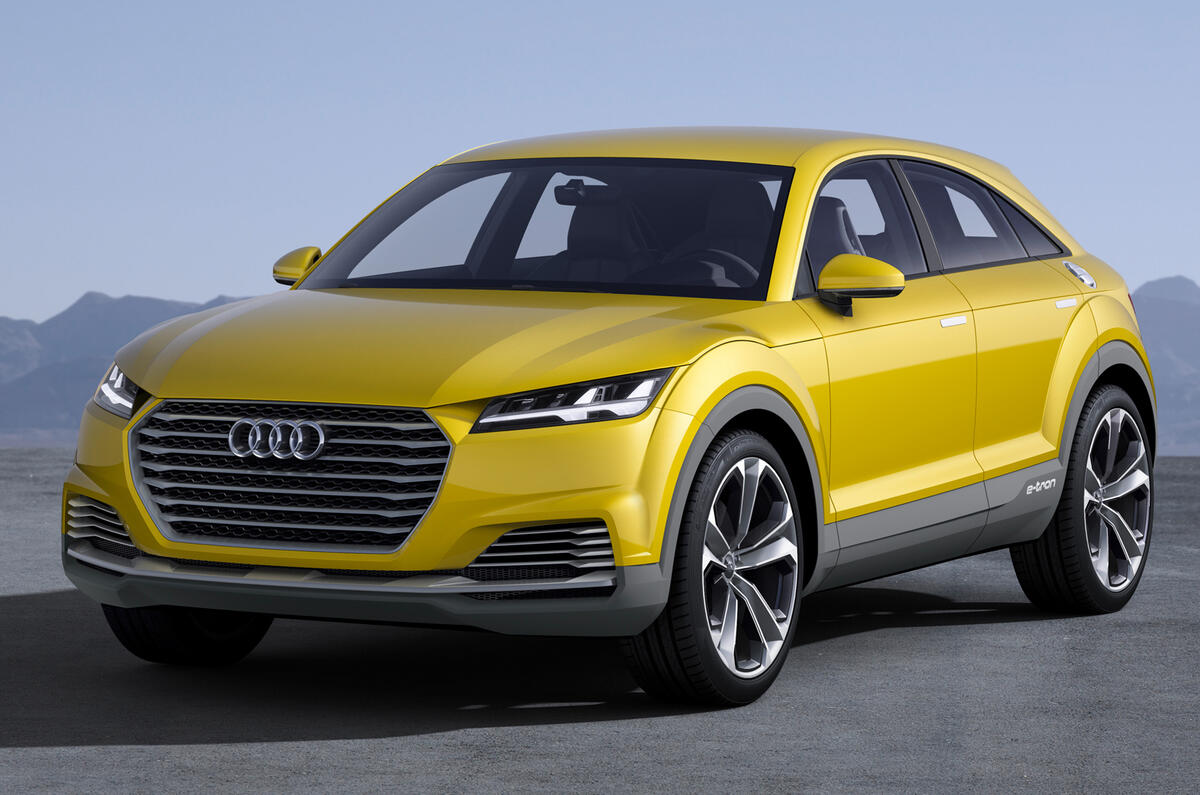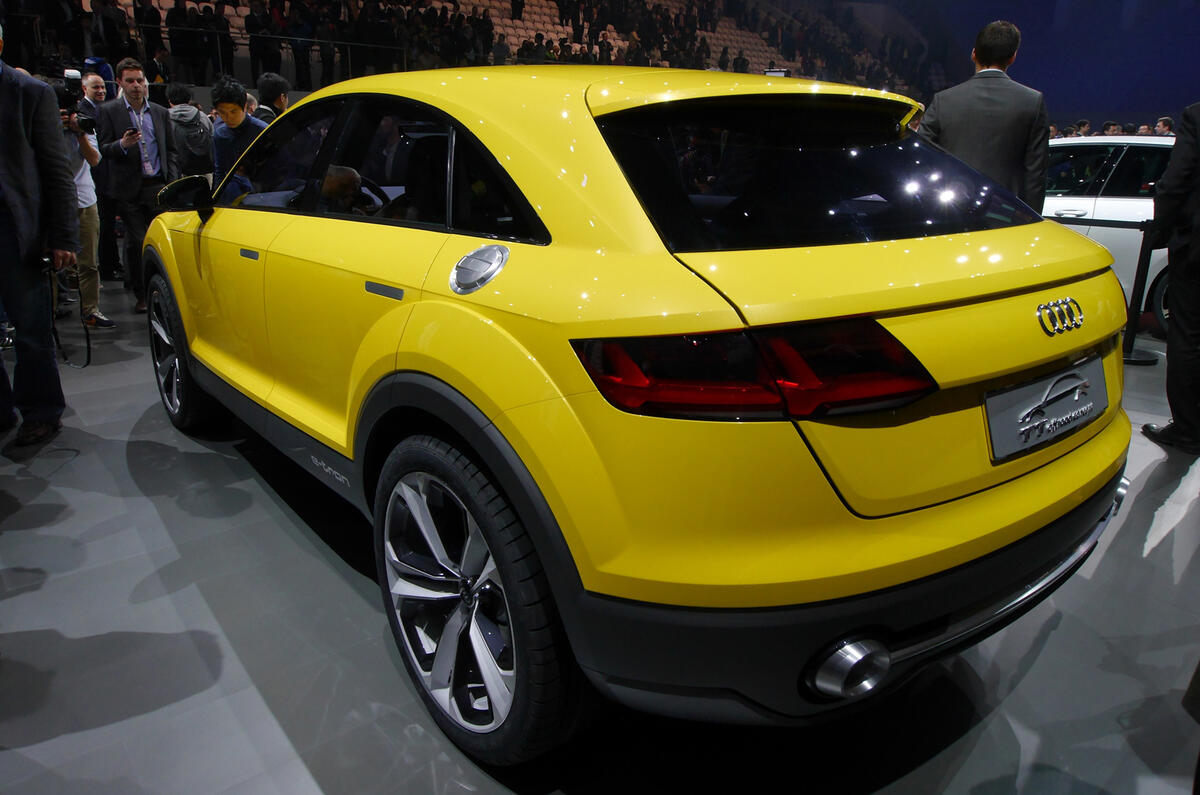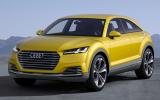The Audi TT offroad concept is the most likely of three Audi TT concept cars from 2014 to make production, technical chief Ulrich Hackenberg has revealed.
Speaking at the LA motor show, Hackenberg said clinics were underway to test the TT offroad concept, alongside the TT Shooting Brake, and the TT Sportback.
“All of the concepts are under analysis,” said Hackenberg. “We’ve done clinics, which have been very positive. They have shown a strong tendency for SUVs, so if we were start with one I’d say there is the strongest chance for the SUV version.”
Any production version of one of the concepts is likely to arrive by 2015 at the earliest.
The TT offroad was first seen at the Beijing motor show in April. It followed the launch of the TT Shooting Brake in January in Detroit, and was followed by the launch of the Sportback at the Paris show in October.
"The Audi TT offroad concept provides a glimpse of how we might imagine a new model in the future TT family," said Hackenberg, speaking at the offroad conceot's unveil in China. "It will be the peak sporting SUV in its class.
"We chose to present the Audi TT offroad concept in China, our second domestic market, because it represents the urban mobility of tomorrow: It is sustainable, dynamic, intelligent and connected".
The concept is a four-door compact SUV that utilises a plug-in hybrid drive system. It's likely that the car, if it were to go into production, would directly rival the Range Rover Evoque, Porsche Macan and BMW X4.
At the front is a turbocharged 2.0-litre TFSI petrol engine that produces 288bhp and 280lb ft. It sends power to the front wheels via a six-speed dual-clutch transmission that features an integrated electric motor, rated at 40kw and 162lb ft.
Mounted on the back axle is a second electric motor that outputs 85kW and 199lb ft. An all-electric range of 31.1 miles is possible, with the total range for the new concept claimed to be 546.8 miles. Electric power comes from a 12kWh battery mounted in front of the rear axle.
It's claimed that the system, which produces 402bhp and 479.2lb ft, allows for an average economy of 148.7mpg. The concept is reputed to be capable of 0-62mph in 5.2sec and has a limited top speed of 155.3mph. CO2 emissions are rated at 45g/km.
Audi's concept additionally features wireless charging, allowing the car to simply be parked over a plate to receive a charge. The manufacturer states that it takes "about as long as charging via a cable" and that the technology is around 90 per cent efficient.














































Join the debate
Add your comment
Very nice concept, but too little and may be already too late...
Its electric motors totaling 125KW # 180HP combined to its 12KWH battery was granting it the 1st descent "all electric mode", that could have allowed me to do "all electric" at least # all my 65KM daily local commutes, and since they represent # 85% of my yearly mileage, shed 85% of the petrol consumed in my car every year, right away.
Main issue for me was the battery still too small, although notably better than all other German PHEV announced this year with far too small #10KWH. This slightly better 12KWH was making a big difference for me, as I could almost do my 65KM daily local commutes with one charge per day, means a good quality 3000 x cycles battery could last # 10 years used that way. While with 10KWH two charges per day are required, so such battery would only last 5 to 6 Years, making the car resale value zero tomorrow, versus lower but descent on this TT OffRoad. Ideal PHEV SUV battery sizing for me, should be 30KWH to 40KWH, allowing a better up to 200KM EV range, and one charge every 2 x days for my local commutes, so battery could last longer, # as much as the rest of the car. But still 12KWH was far better than other German PHEV announced this year with 10KWH, so it would have been my 1st choice, for a 2015 PHEV SUV as main family car replacement, if nothing else had come....
Problem is since this was presented, Tesla speed-ed up their SuperCharger rollout big times in Europe (See it on their site), and while previously I was expecting them to cover my southern Europe Mediterranean and Skying vacation locations within 10 years at best,... Tesla shrunk that to end of 2015... YES in only 1 year from now ! Plus they announced the "D" = Dual Motor on Model S P85D, far more efficient, especially on the motorway at 130KM/H, and said Model X available in 2H15 would be Dual Motor as std. Plus they started to build in Nevada their GigaFactory with the promise that combined with new Panasonic 800Wh/H new cells, it would allow to offer +30% More KWH capacity at the same price and in the same space, when at full speed, likely by 2016.
So I'm currently planning to purchase a (future) Tesla Model X P110D in 2016, and extending my budget > 80K Euros to make that possible. Without improving at least the battery size of this TT OffRoad concept before it reaches production, Audi will not be a winning alternative for me here.
I even think it may be already too late for German vendors to launch a good PHEV SUV optimized on old ICE drive trains like here, especially if that does not allow them to at least reach 30KWH battery. So Audi should better do what Porsche just announced : Porsche shed their Macan eHybrid plan, and few other wrong 10KWH PHEVs, to run faster after TESLA on long range full EV drive trains (Only problem is Porsche decided to put that 1st in future Pajun, instead of a Macan SUV where market opportunity will be larger, due to largest green cities restrictions on SUV in Europe, especially in Paris for me). Once they will have a good long range EV, it would be easy to derivate from it an "optimal" PHEV version, adding a little Range Extender / non-tracting ICE engine on top of a smaller battery model (No need of 85KWH or more on a PHEV with a Range Extender, can go with RE and 30 to 40KWH only, to make a cheaper entry PHEV point here !). Plus they will need a SuperCharge network on top of competitive EVs, as without as fast 135KW Superchargers the long range EVs will be nothing.
Another VW in drag
M